Trades math workbook
On this page
- Introduction
- Math foundations
- Section 1: Measurement and calculation
- Section 2: Money math
- Section 3: Scheduling, budgeting and accounting
- Section 4: Data analysis
Alternate formats

Trades math workbook[PDF - 1.08 MB]
Large print, braille, MP3 (audio), e-text and DAISY formats are available on demand by ordering online or calling 1 800 O-Canada (1-800-622-6232). If you use a teletypewriter (TTY), call 1-800-926-9105.
Introduction
Working in the trades requires strong numeracy skills to help you succeed on the job. This workbook includes questions and learning material to help you:
- learn more about the numeracy skills required to work in the trades
- discover how journeypersons use numeracy on the job
- practice your numeracy skills
- find out which numeracy skills you may need to improve
The workbook is divided into four sections, each of which highlights different numeracy skills that journeypersons use on the job.
-
Measurement and calculation:
Skills used to measure and describe the physical world, for example by taking measurements and calculating area and volume. -
Money math:
Skills used in paying and receiving money on the job, for example in handling cash, making change, preparing bills or making payments. -
Scheduling, budgeting and accounting:
Skills used to manage time and money, for example in planning and keeping track of how you use your time and money, in choosing the products or services that offer the best value and in using your time and money wisely. -
Data analysis:
Skills used to solve problems by analyzing and comparing numerical data.
An answer key is provided at the end of the workbook to help you review your answers and find out which areas of numeracy you may need to improve.
Math foundations
| Math foundation skills | Workplace examples | |
|---|---|---|
| Whole numbers for example: 3, 14 |
Read, write, count, round off, add, subtract, multiply and divide whole numbers. |
|
| Integers for example: -5, 0, 11 |
Read, write, add, subtract, multiply and divide integers. |
|
| Fractions for example: 1/8", 1/4" |
Read, write, round off, add, subtract, multiply or divide fractions. Multiply or divide by a fraction. |
|
| Decimals for example: 8.50, 0.00375 |
Read, write, round off, add or subtract, multiply or divide decimals. Multiply or divide by a decimal. |
|
| Percentages for example: 10%, 42% |
Read and write percentages. Calculate the percentage one number is of another. Calculate a percentage of a number. |
|
| Equivalent numbers for example: 1/2 = 0.5 = 50% |
Convert between fractions, decimals and percentages. |
|
| Other real numbers for example: v36, 92, 2.2 x 103, p |
Use square roots, powers, scientific notation and significant digits. |
|
| Equations and formulas | Solve problems using equations with one unknown quantity. Use formulas by inserting quantities. Solve quadratic equations. |
|
| Rates, ratios and proportions | Use a rate comparing 2 quantities with different units. Use a ratio comparing 2 quantities with the same units. Use a proportion comparing 2 ratios or rates. |
|
| Measurement conversions | Convert between imperial and metric (SI) measurements. Convert to another unit within a measurement system. |
|
| Areas, perimeters and volumes | Calculate areas, perimeters and volumes. |
|
| Geometry | Apply geometric concepts such as parallelism, perpendicularity and tangents. |
|
| Trigonometry | Use trigonometry to determine the size of an unknown side or angle of a triangle. |
|
| Summary calculations | Calculate averages and rates other than percentages, proportions or ratios. | Calculate averages for:
|
| Statistics and probability | Use statistics and probability to draw conclusions. |
|
Section 1: Measurement and calculation
Measurement is the way that numbers are used most often in the trades. Measurement and calculation are used to measure and describe the physical world, for example by taking measurements and calculating area and volume. The following are 3 typical workplace examples of measurement and calculation:
- Construction electricians take measurements and perform calculations to make sure that electrical installations meet electrical code requirements.
- Carpenters take precise measurements using survey equipment.
- Plumbers perform calculations using trigonometry to design, fabricate and install pipe that needs to go around an obstacle.
Using measuring tools
Journeypersons who build things in their work use measuring tapes, laser survey equipment, micrometers, scales and other tools to measure on a daily basis. They work with both imperial and metric measurements on the job.

1. Enter the correct length beside each arrow on the measuring tape. Remember to include the correct unit (inches or centimetres). 2 examples are provided for you.

-
Answer:

Math foundation skills: Whole numbers, fractions, decimals (imperial, metric)
2. Label the following measurements (a–f) on the measuring tape with an arrow and the letter of the question. 2 examples have been done for you.
x. 37 1/2" y. 1.01m
a.39 1/8 in.
b.3 ft. 4 3/4 in.
c. 3.5 ft.
d. 93 cm
e. 0.992 m
f. 107.5 cm

-
Answer:

Math foundation skills: Whole numbers, fractions, decimals (imperial, metric)
3. Carpenters take readings of elevations, directions and lengths of property lines using a levelling rod. The red numbers on the rod represent the number of feet, and the black numbers represent tenths of a foot.
Record the readings below. The first one has been done for you.
Note: The red numbers are larger than the black numbers when they mark an even number of feet (for example, 3.0 feet), but smaller when they appear as “reminders” in between.
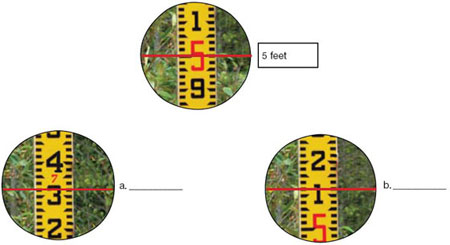
-
Answer:
Question 3a:
- 7.32 feet
- Math foundation skills: Whole numbers, decimals
Question 3b:
- 5.12 feet
Math foundation skills: Whole numbers, decimals
Using formulas
The formulas in the box below will help you solve the workplace problems in this section.
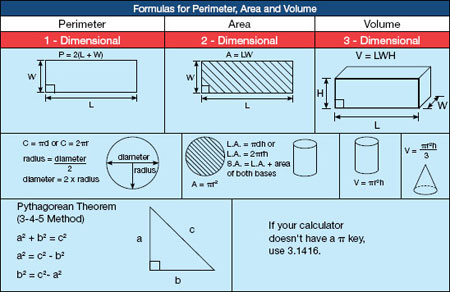
Whether you are in a classroom or on the job, it is helpful to develop your own method for solving math problems involving measurements. The steps below can help you do this.
Steps:
- Draw a diagram and label it with measurements
- Identify the information you need.
- Think about the units you are working with (for example, square metres, loads, feet).
- Decide which formula or formulas you will need to use.
- Calculate the answer.
Note: Use your calculator to complete the questions in this workbook.
- A carpenter is building a temporary fence around a building site. How many metres of fencing are required for a site that is 47.8 m × 30.3 m? Round your answer up to the nearest metre.
Use the problem-solving steps:
- Draw
- Decide
- Calculate
-
Answer:
2 (47.8 m + 30.3 m) = 156.2 = 157 m
Math foundation skills: Perimeters (metrics)
- How many studs will a carpenter need to frame the exterior walls of the building below? Use the formula given below to estimate the number of studs
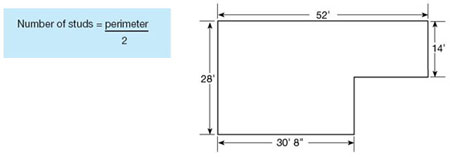
-
Answer:
52' + 14' + (52' – 30' 8") + (28' – 14 ‘) +
30' 8" + 28' = 160'
160 ÷ 2 = 80 studs
Math foundation skills: Perimeters (imperial)
-
- How many 3.7 L containers of bonding product does a floorcovering installer need to install vinyl sheet flooring in a room measuring 9.2 m × 7.8 m?
Only full containers can be ordered.
Typical recommended trowel and approximate coverage. Typical recommended trowel
(depth, width, space)Approximate coverage Trowel Fibrous felt-backed vinyl sheet goods:
1/32" × 1/16" × 1/32"
(0.8 mm × 1.6 mm × 0.8 mm)185–245 sq. ft./U.S. gal.
(4 5–6 0 m2/L)
-
Answer:
9.2 m × 7.8 m = 71.76 m2
71.76 m2 ÷ 4.5 m2/L = 15.95 L
15.95 L ÷ 3.7 L = 4.31 = 5 containers
Math foundation skills: Area (metrics)
-
- A bricklayer is covering a playground surface with rubber tiles. Each 2-ft 2 tile costs $13.29. Calculate how much it will cost to cover the playground.
Note: Only whole tiles can be ordered, so you will need to round your answer up when you calculate how many tiles are needed.
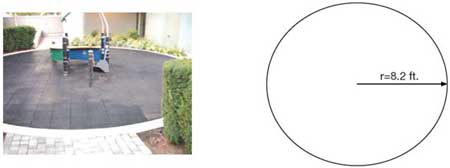
-
Answer:
3.1416 (8.2 ft. × 8.2 ft.) = 211.24 ft.2
(211.24 ft.2 ÷ 2 ft. 2/tile) = 105.62 = 106 tiles
106 tiles × $13.29/tile = $1,408.74
Math foundation skills: Area (imperial)
-
- A landscape horticulturalist needs to order enough sand to create a border 152 mm deep around a square surface, as shown below. How many cubic metres of sand are needed?

-
Answer:
(14 m)2 – (9.25 m)2 = 110.44 m2
110.44 m2 × 0.152 m = 16 79 m3
Math foundation skills: Volume (metrics)
-
- A construction craft worker needs to know how much material is in the cone-shaped pile shown below. Calculate the approximate volume of the pile in cubic yards.
Use this formula to calculate the radius of a pile of material:
r = ¾ × height
27 ft. 3 = 1 yd. 3
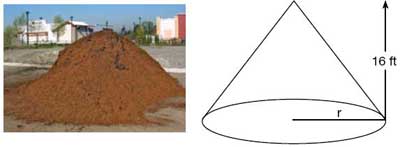
-
Answer:
r = ¾ × 16 ft. = 12 ft.
(3.1416 × (12 ft.)2 × 16 ft.) ÷ 3 = 2 412.75 ft. 3
2 412.75 ft. 3 ÷ 27 ft. 3/yd 3 = 89.36 yd 3
Math foundation skills: (Volume imperial)
-
-
Heat and frost insulators cover pipes to keep substances hot or cold. How many square metres of material are needed to insulate a pipe that is 6 m long and has a diameter of 2 m?
Think of the cylinder as being laid out flat so that the circumference becomes the width measurement.
Use this formula: pdh
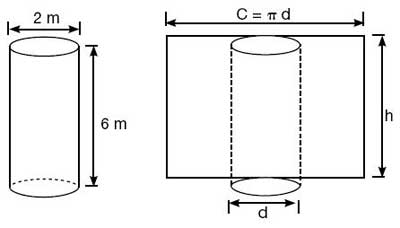
-
Answer:
3.1416 × 2 m × 6 m = 37.6992 = 37.7 m2
Math foundation skills: Area (metrics)
-
-
Electricians calculate the total resistance of parallel electrical circuits. Use the formula below to calculate the total resistance for the circuit shown.

-
Answer:
8 ohms ÷ 4 resistors = 2 ohms
Math foundation skills: Equations and formulas
-
-
Plumbers fit pieces of pipe for custom jobs. What is the centre-to-centre (c–c) length of the pipe shown below?
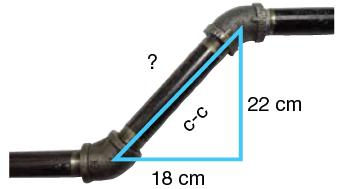
-
Answer:
222 + 182 = 808
v808 = 28.43 cm
Math foundation skills: Trigonometry
-
-
Carpenters perform calculations to help them lay out and construct wooden stairs. Calculate the length of the stringer (c) for the stairs shown below.
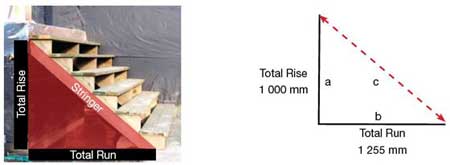
-
Answer:
1 0002 + 1 2552 = 2 575 025
v2 575 025 = 1 605 mm
Math foundation skills: Trigonometry
-
-
Refrigeration and air conditioning mechanics and sheet metal workers build and install transition elbows to connect different sizes of ducts. Calculate the length of the diagonal side of the transition elbow shown below.

-
Answer:
152 + (12– 8)2 = 241
v241 = 15.52 inches
Math foundation skills: Trigonometry
-
-
Plumbers calculate water pressure in pounds per square inch (psi). What is the water pressure for a 28-foot vertical pipe full of water?
Use this formula:
Water pressure (psi) = h × 0.433
-
Answer:
28 × 0.433 = 12.12 psi
Math foundation skills: Equations and formulas
-
-
Sheet metal workers install ducts in buildings.
The equation below shows the relationship between:
- airflow volume in cubic feet per minute (V);
- air velocity in feet per minute (v); and
- area of a cross-section of duct in square feet (A).
V = A × v
a. Calculate the area in square feet of a cross-section of an 8 in. × 24 in. duct.
1 ft. 2 = 144 in. 2
b. Calculate the airflow volume if the air velocity in the same duct is 1,200 feet per minute.
-
Answer:
Question 13a:
- 8 in. × 24 in. = 192 in. 2
- 192 in. 2 ÷ 144 in. 2/ft. 2 = 1.33 ft 2
- Math foundation skills: Area (imperial)
Question 13b:
- 1.33 ft. 2 ×1 200 ft. /min = 1 596 ft. 3/min
- Math foundation skills: Equations and formulas
Using drawings
Journeypersons working on a construction site follow specifications from a set of drawings or prints that show different views of the finished building project. Journeypersons in all trades scan the drawings for the detailed information they need.
Journeypersons often convert inches to fractions or decimals of a foot.
3 in = ¼ ft. or 0.25 ft.
6 in = ½ ft. or 0.5 ft.
9 in = ¾ ft. or 0.75 ft.
12 in = 1.0 ft.
Adding and subtracting feet and inches:
Step 1: Line up the measurements so that like units are under like units.
Step 2: Add or subtract the inches. Add or subtract the feet.
Step 3: Change the inches to feet (divide by 12).
Step 4: Add your answer from step 3 to the number of feet from step 2.
Example:
Step 1
7 ft. 11 in.
+ 2 ft. 9 in.
___________
Step 2
7 ft. 11 in.
+ 2 ft. 9 in.
___________
9 ft. 20 in.
Step 3
20 in. = 1 ft. 8 in.
Step 4
9 ft.
+ 1 ft. 8 in.
___________
10 ft. 8 in.
Look at the drawings for a residence to complete the questions below.
- The walk-in closet measures 1¼ in. × 1½ in. on the drawing. What are the actual dimensions of the closet?
-
Answer:
5/4 × 1 ft. = 5 ft.
3/2 × 1 ft. = 6 ft.
Dimensions = 5 ft. × 6 ft.
Math foundation skills: Rates, ratios and proportions
-
- How many pocket (sliding) doors are needed?

-
Answer:
3
Math foundation skills: Whole numbers
-
- What is the exterior length from A to B?
-
Answer:
2' 2" + 8' + 2' 2" = 12' 4"
Math foundation skills: Measurement conversions
-
- Carpet costs $28.50 per square yard. What is the cost of carpet for the master bedroom and closet?
1 yd.2 = 9 ft.2
-
Answer:
A = 12 ft. ×14 ft. = 168 ft.2
168 ft.2 + 30 ft.2 = 198 ft.2
198 ft.2 ÷ 9 ft. 2/yd.2 = 22 yd.2
$28.50/yd.2 × 22 yd.2 = $627.00
Math foundation skills: Area, measurement conversions
-
- Estimate the number of drywall sheets needed for the walls of the ensuite bathroom.
Drywall sheets: 4 ft. × 8 ft.
Height of room: 8 ft
Width of pocket door: 3 ft.
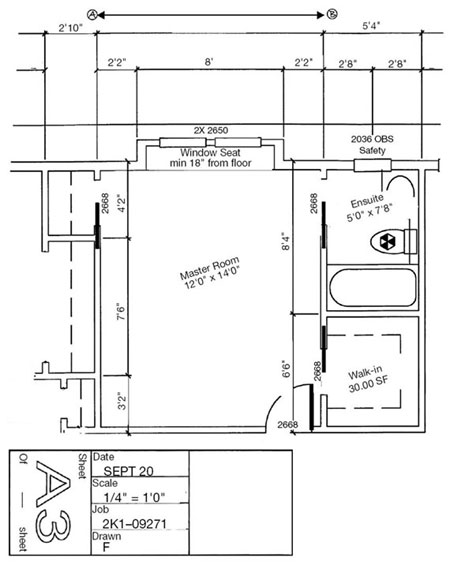
-
Answer:
Method 1:
- Height of drywall sheets = height of room
- 5 ft. + 7.67 ft. + 5 ft. + 7.67 ft. = 25.34 ft.
- 25.34 ft. – 3 ft. = 22.34 ft.
- 22.34 ft ÷ 4 ft. /sheet = 5.585 = 6 sheets
Method 2:
- 5 ft. + 7.67 ft. + 5 ft. + 7 67 ft. = 25.34 ft.
- 25.34 ft. – 3 ft. = 22.34 ft.
- 22.34 ft. × 8 ft. = 178.72 ft.2
- 4 ft. × 8 ft. = 32 ft.2
- 178.72 ft. 2 ÷ 32 ft.2 = 5.585 = 6 sheets
-
Estimating weight loads
Mobile crane operators estimate weight loads. Calculating safe loads protects the equipment, the materials it carries, the workers on the job site and the general public.
Practice exercise
Estimate the weight of a 4 ft. × 18 in. aluminum plate 3/8 in. thick.
Aluminum plate 1/8 in. thick weighs approximately 1.75 pounds per square foot.

Steps:
-
Draw a diagram and label it with the measurements.
-
Calculate the area.
Area = L × W
= 4 ft. × 1.5 ft.
= 6 ft.2 -
Calculate the weight.
a) Weight of 1 ft.2 of 3/8 in. aluminum plate: --> 3/8 in. ÷ 1/8 in. = 3 --> 1.75 lb./ft.2 × 3 = 5.25 lb./ft.2
b)
Area of plate
× Weight per square foot:
_____________________
= Weight in pounds6 ft.2
× 5.25 lb./ft.2
_______________
= 31.5 lb.The aluminum plate
weighs approximately
31.5 pounds.
- Boilermakers and ironworkers estimate the weight of materials used in fabrication. Calculate the approximate weight of a 2 ft. × 18 ft. steel plate ¾ in thick.
1" steel plate weighs about 40 lb./ft.2.
-
Answer:
2 ft. × 18 ft. = 36 ft.2
¾ × 40 lb. /ft.2 = 30 lb. /ft.2
36 ft.2 × 30 lb. /ft.2 = 1 080 lb.
Math foundation skills: Equations and formulas
-
- A mobile crane operator estimates the weight of a concrete panel to make sure that the crane can lift it safely. Calculate the approximate weight of the panel shown below.
Reinforced concrete weighs about 150 lb./ft.3.
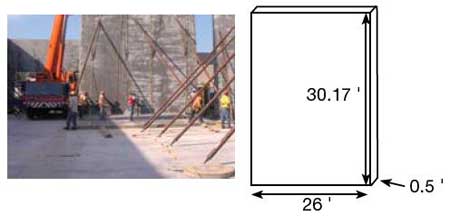
-
Answer:
26' × 30.17' × 0.5' = 392.21 ft.3
392.21 ft. 3 × 150 lb. /ft.3 = 58 831.5 lb.
Math foundation skills: Equations and formulas
-
Working with quantities
Rates and ratios are used to compare 2 quantities. Both can be expressed in the following forms: 1 to 2, 1:2 or ½.
Rates compare 2 quantities with different units. For example, a rate can be used to describe the flow of a liquid in litres per second.
Example: 1 tablespoon of flour : 1 cup of milk
Ratios compare 2 quantities with the same units. For example, a ratio can be used to describe the number of parts of water and colouring agents to combine.
Example: 1 part water
___________
2 parts cement
Proportions compare 2 ratios or 2 rates.
- A sewer line slopes at ¼" per foot. Calculate the total fall in 30 feet.
Use this formula:
Total fall = length × grade-
Answer:
Total fall = 30 ft. × ¼ in/ft. = 7.5 ft.
Math foundation skills: Rates, ratios and proportions
-
-
Automotive service technicians occasionally need to convert kilometres to miles for American customers. An oil change is due at 35,000 km. What is the same distance in miles?
1 km = 0.6214 mi.
-
Answer:
35 000 km × 0.6214 mi/km = 21 749 mi.
Math foundation skills: Rates, ratios and proportions
-
- A hairstylist is mixing a hair treatment. The client has long hair, so the hairstylist starts with 1¼ scoops of powder lightener.
Mixing: Measure 1 level scoop of powder lightener into a non-metallic bowl or bottle. Add 1 oz. (30 g) of the booster and 2 fl. oz. (60 mL) of conditioning creme. Mix thoroughly to achieve a creamy consistency.
a. Calculate the number of grams of booster needed.
b. Calculate the number of millilitres of conditioning creme needed.
-
Answer:
Question 3a:
- 5/4 × 30 g = 37.5 gMath foundation skills: Rates, ratios and proportions
Question 3b:
- 5/4 × 60 mL = 75 mL
Math foundation skills: Rates, ratios and proportions
-
-
Cooks often change the yield of recipes to serve more or fewer customers. The following recipe makes 30 pancakes. Adapt the recipe to make 75 pancakes.
Use proportions to calculate how much of each ingredient is needed. The first ingredient is done for you using 2 different methods.
Method 1:
625 g = ? g
____ ____
30 75625 x 75 = 46875 ÷ 30 = 1562.5 g
____
30Method 2:
625 ÷ 30 = 20.883
75 x 20.833 = 1562.5 g
Ingredient measurements Ingredient Amount for 30 Amount for 75 Flour 625 g 1562.5 g Sugar 60 g Baking powder 30 g Eggs 4 Milk 1 L Melted butter 125 g -
Answer:
amount × 75 = quantity of ingredients
___________
30sugar – 150 g; baking powder – 75 g;
eggs – 10; milk – 2.5 L: butter 312.5 g
Math foundation skills: Rate, ratios and proportions
-
- Product labels provide information about quantities to mix. Use the label to answer the questions below it.
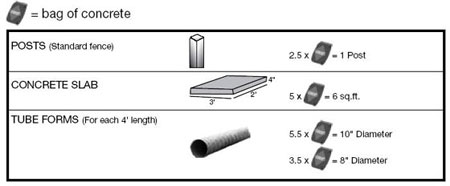
- A carpenter is building a fence with 9 posts. How many bags of concrete are required to set the posts?
- Calculate the number of bags of concrete mix required for a slab measuring 5' × 2'4" × 6".
- Tube forms are used to form concrete columns. The concrete is mixed at a ratio of 2.5 litres of water per bag of concrete mix. Calculate the amount of water needed for a 15-foot column with a diameter of 8 inches.
-
Answer:
Question 5a:
- 9 posts × 2.5 bags/post = 22.5 = 23 bagsMath foundation skills: Rates, ratios and proportions
Question 5b:
- 5 bags = 3 ft. × 2 ft. × .33 ft. = 1.98 ft.3
- 5 ft. × 2.33 ft. × 0.5 ft. = 5.825 ft.3
- 5.825 ft. 3 ÷ 1.98 ft.3 = 2.94
- 2.94 × 5 bags = 14.7 = 15 bags
- Math foundation skills: Rates, ratios and proportions
Question 5c:
- 15ft. ÷ 4 ft. = 3.75
- 3.75 × 3.5 = 13.125 = 14 bags
- 14 bags × 2.5 L/bag = 35 litres of water
- Math foundation skills: Rates, ratios and proportions
Section 2: Money math
Money math is used in paying and receiving money on the job, for example in handling cash, preparing bills or making payments. The following are 3 typical workplace examples of money math.
- Cooks use petty cash to purchase small quantities of supplies that are needed immediately.
- Hairstylists prepare bills and collect cash, debit and credit card payments for their services. They charge a set rate for each service and add applicable taxes, such as the GST.
- Automotive service technicians calculate the total cost of repair jobs including parts, labour, markup and taxes, and enter these amounts on estimates or finished work orders.
Calculating increases and decreases
In some shops, products are bought at wholesale prices and marked up to sell to customers. Here is one way to calculate markup and sales tax.
| Method | Examples |
|---|---|
|
Markup
|
An item with a wholesale price of $14.35 is marked up 22%. Calculate the selling price. 100% + 22% = 122% 122/100 = 1.22 1.22 × $14.35 = 17.507 = $17.51 |
|
Sales tax
|
Calculate the after-tax cost of 2 hours of labour at a rate of $45/hour. 2 hours × $45.00 = $90.00 labour cost 100% + 7% = 107% 107/100 = 1.07 1.07 × $90.00 = 96.3 = $96.30 |
Products are sometimes discounted when they are discontinued or when the supplier has a promotion. Here is one way to calculate a discount.
| Method | Examples |
|---|---|
|
An item with a regular price of $10.89 is discounted 15% Calculate the sale price. 100% – 15% = 85% 85/100 = 0.85 0.85 × $10.89 = 9.257 = $9.26 |
-
In a hair salon, products are marked up for resale. Calculate the selling prices of the items listed below.
Calculate the selling prices of the items Wholesale price Markup Selling price a. $97.25 10% b. $249.99 15% c. $6.50 8% -
Answer:
Question 1a:
- (1.00 + 10/100) × $97.25 = $106.98
- Math foundations skills: Percentages
Question 1b:
- 1.15 × $249.99 = $287.49
- Math foundations skills: Percentages
Question 1c:
- 1.08 × $6.50 = $7.02
- Math foundations skills: Percentages
-
-
Calculate the after-tax cost of the items listed below.
Calculate the after-tax cost of the items Cost Tax Total a. $73.50 12% b. $1,847.00 13% c. $86.75 8% -
Answer:
Question 2a:
- 1.12 × $73.50 = $82.32
- Math foundation skills: Percentages
Question 2b:
- 1.13 × $1,847 = $2,087.11
- Math foundation skills: Percentages
Question 2c:
- 1.08 × $86.75 = $93.69
- Math foundation skills: Percentages
-
-
In a hair salon, products are discounted for promotions. Calculate the sale prices of the items listed below.
Calculate the sale prices of the items Price Discount Sale price a. $85.40 10% b. $1,348.00 33% c. $459.75 40% -
Answer:
Question 3a:
- (1.00 – 10/100) × $85.40 = $76.86
- Math foundation skills: Percentages
Question 3b:
- 0.67 × $1,348 = $903.16
- Math foundation skills: Percentages
Question 3c:
- 0.60 × $459.75 = $275.85
- Math foundation skills: Percentages
-
Invoicing for services
Journeypersons who install, maintain and repair equipment often make invoices for services and are paid in cash, by cheque or by credit card on the job. Calculating tax is a typical task in these situations.
1. a) Complete the invoice on the next page for the following services:
- Repair dishwasher
- Model #MDB7601AWW
- Clean pump assembly, Test OK
- Labour 1.2 hours at $88.25 per hour (5% GST)
- Parts $2.80 (5% GST + 6% PST)
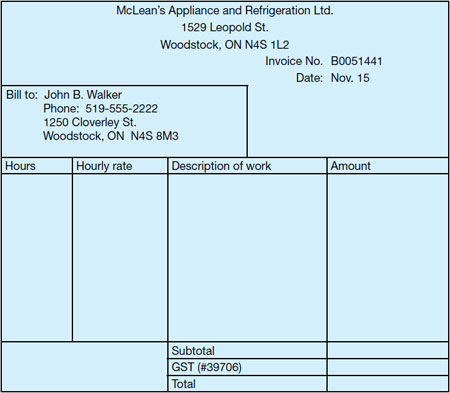
b) The customer pays the bill in cash using the following amounts:
1 × $100
1 × $20
1 cent
How much change should the technician give the customer? Enter the amounts of money that could be given as change in the table below. (There are several correct answers.)
| $50 | $20 | $10 | $5 | $2 | $1 | 25¢ | 10¢ | 5¢ | 1¢ |
|---|---|---|---|---|---|---|---|---|---|
-
Answer:
Question 1a:
- $105.90 × 1.05 = $111.20 (labour)
- $2.80 × 1.11 = $3.11 (parts)
- $111.20 + $3.11 = $114.31
- Math foundation skills: Decimals
Question 1b:
Change: $120.01 – $114.31 = $5.70
$50 $20 $10 $5 $2 $1 25¢ 10¢ 5¢ 1¢ 1 2 2 Math foundation skills: Decimals
Section 3: Scheduling, budgeting and accounting
Scheduling, budgeting and accounting are used to manage time and money, for example in planning and keeping track of how you use your time and money, in choosing the products or services that offer the best value and in using your time and money wisely. The following are 3 typical workplace examples of scheduling, budgeting and accounting.
- Industrial mechanics (millwrights) schedule tasks for construction, repair and maintenance projects. They also create maintenance schedules for equipment in manufacturing plants.
- Machinists adjust daily work schedules to accommodate rush jobs or jobs that take longer than estimated. For example, they may change machining processes or the order of jobs. They consider whether others are affected by changes in the workflow and try to minimize the disruption.
- Cooks establish weekly budgets that include the cost of fresh food, shelf items and kitchen staff requirements. They also establish separate budgets for each of the catering events for the week. The costs included in the catering budgets vary depending on the menu items, number of courses and number of people served.
Comparing values
Use a table structure to compare items.
| Points of comparison | Item 1 | Item 2 | Item 3 |
|---|---|---|---|
| Cost 1 | |||
| Cost 2 | |||
| Cost 3 |
The problems in this section require you to locate and understand information in documents.
Coating products can be applied by either a trowel-on or a roll-on method.
- A concrete finisher estimates the cost of resurfacing the sidewalk pictured using 2 different methods for placing concrete. The trowel-on method lasts longer but costs more.
Estimate the cost difference given:
- The concrete finisher charges $37.50 per hour;
- Each coat takes approximately 1 hour and 30 minutes to apply.
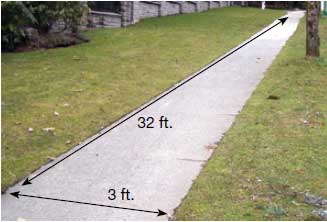
| Component | 9.29 m2
(100 sq. ft.) |
18.58 m2
(200 sq. ft.) |
27.87 m2
(300 sq. ft.) |
37.16 m2
(400 sq. ft.) |
|---|---|---|---|---|
| No primer required | ||||
| Step 1: Roll-on stone coat $89.00/ 9.2 L |
1 × 9.2 L | 2 × 9.2 L | 3 × 9.2 L | 4 × 9.2 L |
| Step 2: Protective top coat $26.78/946 mL |
1 × 946 mL | 2 × 946 mL | 1 × 3.78 L | 1 × 3.78 L |
| Component | 9.29 m2
(100 sq. ft. ) |
18.58 m2
(200 sq. ft. ) |
27.87 m2
(300 sq. ft. ) |
37.16 m2
(400 sq. ft. ) |
|---|---|---|---|---|
| Step 1: Primer coat $48.20/3.78 L |
1 × 3.78 L | 1 × 3.78 L + 1 × 946 mL |
2 × 3.78 L | 3 × 3.78 L |
| Step 2: Trowel-on stone coat $115.07/15.1 L $53.25/3.78 L |
1 × 15.1 L + 2 × 3.78 L |
3 × 15.1 L | 4 × 15.1 L + 2 × 3.78 |
6 × 15.1 L |
| Step 3: Protective top coat $26.78/946 mL |
1 × 946 mL | 2 × 946 mL | 1 × 3.78 L | 1 × 3.78 L |
-
Answer:
Area of sidewalk = 32 ft. × 3 ft. = 96 ft.2
Roll-on: (1 5 h × 2) × $37.50/h = $112.50
$89.00 + $26.78 = $115.78
$112.50 + $115.78 = $228.28
Trowel-on: (1.5 h × 3) × $37.50 = $168.75
$48.02 + $115.07 + (2 × $53.25) + $26.78 = $296.55
$168.75 + $296.55 = $465.30
$465.30 – $228.28 = $237.02
The trowel-on method costs about $240.00 more
Math foundation skills: Decimals
Accounting for cost
Many journeypersons give estimates to customers. This involves telling the customer approximately how much he or she should expect to pay for a certain item.
In the example below, a journeyperson estimates that a sink will cost $100. If the sink is not purchased or costs less than $100, the savings are shown in brackets. This means the actual cost is less than budgeted.
| Item | Allowance ($) | Actual ($) | Difference +/- ($) |
|---|---|---|---|
| Sink | 100.00 | 75.99 | (24.01) |
If the sink costs more than $100, the extra cost is shown without brackets. This means the actual cost is more than budgeted.
| Item | Allowance ($) | Actual ($) | Difference +/- ($) |
|---|---|---|---|
| Sink | 100.00 | 123.67 | 23.67 |
- Journeypersons compare estimates with actual costs. When the customer selects the specific item they want to purchase, the journeyperson can point out how much higher or lower than estimated the actual cost will be.
Use the renovation invoice below to answer the following questions.
-
Compare the allowance for the floor coverings with the actual cost. Enter the difference on the invoice.
-
A contractor is bidding on apartment renovations and needs to submit an estimate for installing the same bathroom mirror, wall tile and toilet in 5 units. Use the actual costs from the invoice to calculate the estimate the contractor should provide. Add 10% to account for rising costs.
-
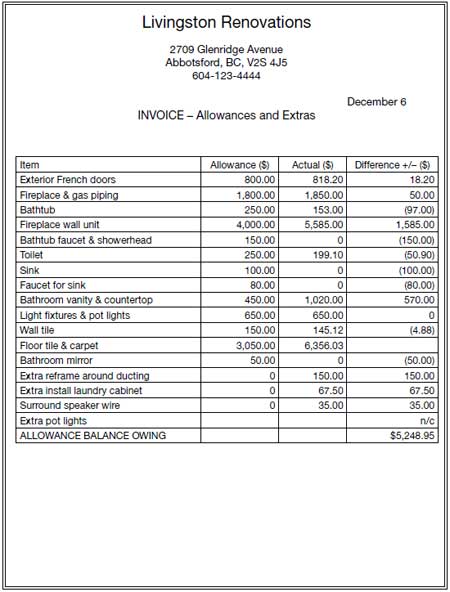
-
Answer:
Question 1a:
- $3,050 – $6,356.03 = –$3,306.03
- Entry on invoice: (3,306.03)
- Math foundation skills: Integers
Question 1b:
- ($153.00 + $145.12 + $199.10) × 5 = $2,486.10
- 1.10 × $2,486.10 = $2,734.71
- Math foundation skills: Integers
Section 4: Data Analysis
Data analysis is used to solve problems by analyzing and comparing data. The need for these skills is increasing as computer programs make data more available. The following are three typical workplace examples of data analysis.
- Automotive service technicians analyze readings from tests of vehicle electrical systems to diagnose problems such as an engine that will not start.
- Machinists review quality control data to examine trends in machine performance. For example, they may compare the finished dimensions of parts produced at different points in the machining cycle to decide when to replace tooling or recalibrate machinery.
- Construction electricians use the results of electrical measurements (e g, draw, voltage, torque and temperature) taken at several points in a circuit to analyze circuit operation, to troubleshoot electrical problems and to increase electrical efficiency.
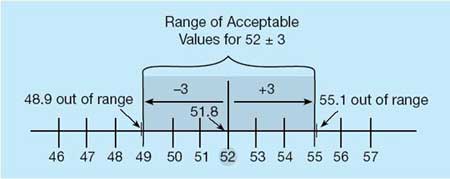
Calculating tolerances
-
Sheet metal workers, machinists, refrigeration and air conditioning mechanics work to very tight tolerances. Decide if the measures in the following table are within specifications. If they are, place a v in the table; if they are not acceptable, place an X.
± means plus or minusTable showing if measures are within specification Specification Measure v/X a. 22.5° ± 2° 20.1° b. 0.850 m ± 0.020 m 0.827 m c. 0.750 L ± 0.015 L 0.761 L -
Answer:
Question 1a:
- X not acceptable
- 22.5° – 2° = 20.5°
- 20.1° is not between 20.5°
- and 22.5° = not acceptable
- Math skills foundation: Integers
Question 1b:
- X not acceptable
- 0.850 m – 0.020 m = 0.830 m
- 0.827 m is not between 0.830 m and 0.850 m = not acceptable
- Math skills foundation: Integers
Question 1c:
- ✓acceptable
- 0.750 L + 0.015 L = 0.765 L
- 0.761 L is between 0.750 L and 0.765 L =
- acceptable
- Math skills foundation: Integers
-
-
An ironworker rigging a load plans to use a ¾-inch wire-rope choker hitch to lift a beam that weighs 4.6 tons. Use the table below to make a recommendation for a safer lift. (There are several correct answers.)
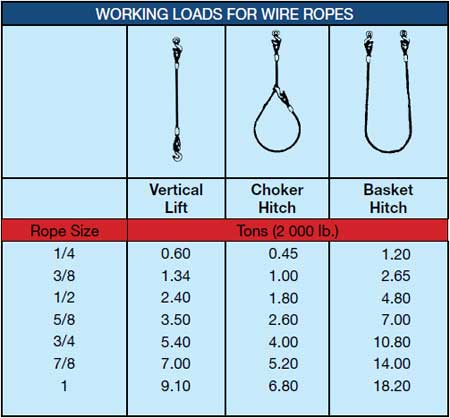
Note: This capacity table is for this workbook only. On the job you should use the manufacturer's table.
-
Answer:
- use a 3/4" rope and a vertical lift (5.4 tons max )
- use a 7/8" rope and a choker hitch (5.2 tons max )
Math foundation skills: Integers
Using numbers in patterns
-
Automotive service technicians use diagnostic equipment to analyze problems in exhaust systems. When the system is operating correctly, the Y or vertical axis on the graph should show signals that constantly change from under 0.2 volts to over 0.8 volts.
The graph below shows 2 sets of numerical data. The top set shows the reading from the driver’s side of the engine and the bottom set shows the reading from the passenger’s side.
How are the 2 sets of graph lines different?
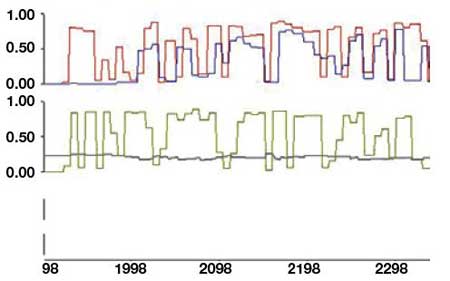
-
Answer:
In the top set, both lines fluctuate from under 0.2 volts to over 0 8 volts. In the bottom set, only one line is showing this pattern. The other line remains almost flat around 0.2 volts.
Math foundation skills: Statistics and probability
-